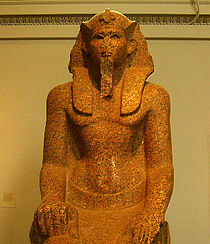- Sobekemsaf I
-
Sobekemsaf I Faraón de la Dinastía XVII de Egipto 
Reinado c. 1619 a 1603 a. C Predecesor Rahotep Sucesor Dyehuti Consorte Nubemhet Sejemra Uadyjau - Sobekemsaf o Sobekemsaf I, faraón de la dinastía XVII de Egipto, durante el segundo periodo intermedio, que gobernó c. 1619-1603 a. C.[1]
La esposa y reina principal de Sobekemsaf fue Nubemhet.
El hijo de Sobekemsaf I, también denominado Sobekemsaf, está representado en una estatua del Museo Egipcio de El Cairo, CG 386, procedente de Abidos; el joven príncipe está situado entre las piernas de su padre (Ryholt)
El Canon Real de Turín (11.2), parcialmente legible, indica su posible nombre: (Sejemra ...) 16..., asignándole 16 años de reinado.
Está documentado en una serie de inscripciones en las rocas de Uadi Hammamat, en el desierto oriental, que contienen su nombre. Estas inscripciones están fechadas en su 7º año de reinado (Ryholt)
En los bajorrelieves de los muros del templo al dios Montu, en Medamud, está representado el faraón Sobekemsaf I con el nombre de trono: Sejemra Uadyjau.
- Algunos académicos estiman que pudiera haber reinado al final de la dinastía XIII.
Titulatura
Titulatura Jeroglífico Transliteración (transcripción) - traducción - (referencias) Nombre de Horus: 


ḥtp nṯrw (Hotep necheru) Nombre de Nebty: 




ˁ š(ȝ) ḫprw (Asha jeperu) Nombre de Hor-Nub: 
![M17 [i] i](/w/extensions/wikihiero/img/hiero_M17.png)
![N35 [n] n](/w/extensions/wikihiero/img/hiero_N35.png)





ỉnḳ tȝ.wy (Ineq tauy) Nombre de Nesut-Bity: 





sḫm rˁ wȝḏ ḫˁw (Sejemra Uadyjau)
Poderoso es RaNombre de Nesut-Bity: 





sḫm rˁ ... (Sejemra ...)
Ra es poderoso, ...
(Canon Real de Turín 11.2)Nombre de Sa-Ra: 

![G17 [m] m](/w/extensions/wikihiero/img/hiero_G17.png)

![I9 [f] f](/w/extensions/wikihiero/img/hiero_I9.png)
sbk m sȝ.f (Sobekemsaf)
Sobek es nuestra protecciónReferencias
- Notas
- ↑ Franke
- Referencias digitales
- Sobkemsaf Sekhemre-Wadjkhaw, en digitalegypt, University College London (en inglés)
- http://www.narmer.pl/dyn/17en.htm (en inglés)
- J. von Beckerath, 1997: Dinastía XVII (en inglés)
- K.S.B. Ryholt, 1997: Dinastía XVII (en inglés)
Enlaces externos
 Wikimedia Commons alberga contenido multimedia sobre Sobekemsaf I. Commons
Wikimedia Commons alberga contenido multimedia sobre Sobekemsaf I. Commons
Predecesor:
RahotepFaraón
Dinastía XVIISucesor:
DyehutiCategorías:- Faraones
- Dinastía XVII
- Reyes del siglo XVII a. C.
- Egipcios del siglo XVII a. C.
Wikimedia foundation. 2010.
